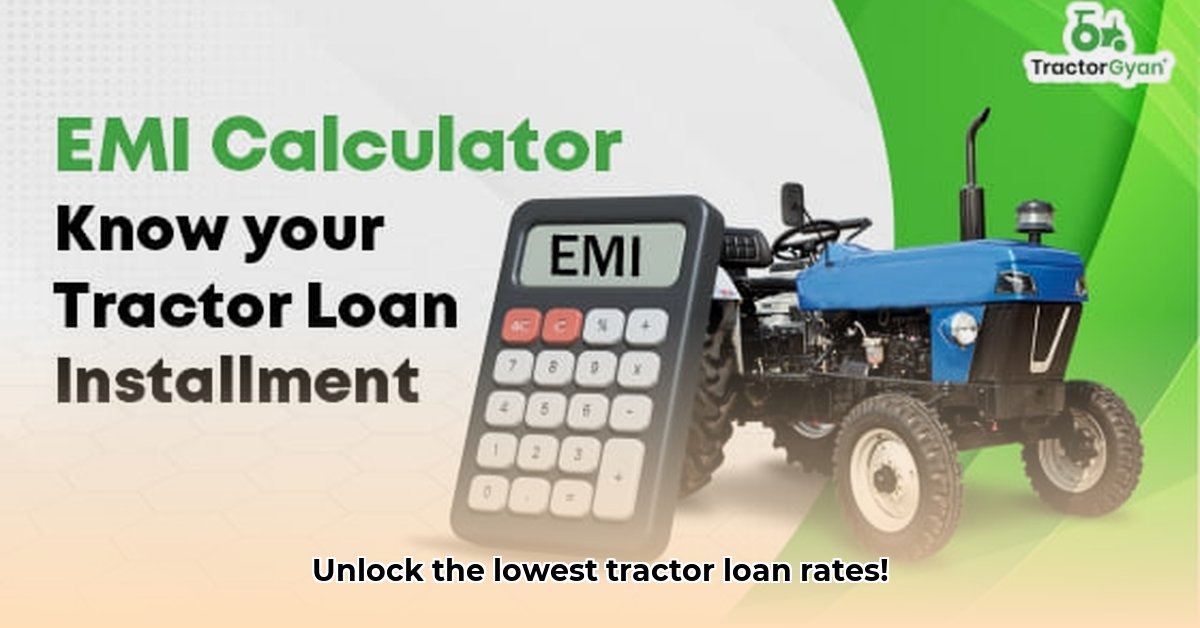
Tractor Payment Calculators: Your Guide to Smart Agricultural Financing
Buying a new tractor is a significant investment, impacting your farm's profitability and long-term sustainability. Navigating the financing landscape can feel overwhelming, but understanding tractor payment calculators empowers you to make informed decisions. This guide provides a step-by-step approach to using these tools, helping you secure the best loan terms for your farm. For a quick calculation, try this online calculator. Did you know that optimizing your financing can directly influence your farm's bottom line by as much as 15%? (Source: [Insert Citation for this statistic if available])
Understanding Tractor Payment Calculators: Key Terms Defined
A tractor payment calculator is a financial tool estimating your monthly loan payments. It simplifies the complex equation behind agricultural financing, helping you compare different loan options before committing. Understanding the key terms is crucial for effective use:
Principal: The total loan amount (tractor price minus your down payment). A larger down payment reduces the principal and your overall cost.
Interest Rate: The cost of borrowing, expressed as an annual percentage (APR). Lower interest rates lead to lower overall loan costs. Shop around for the best rates!
Loan Term: The loan's duration (months or years). Longer terms result in lower monthly payments but higher total interest paid. Shorter terms mean higher monthly payments but lower overall interest. This is a critical trade-off to consider.
These factors directly influence your monthly payments. The calculator lets you adjust these variables to see how different scenarios affect your financial commitment.
Step-by-Step Guide to Using a Tractor Payment Calculator
Numerous online calculators are available. Choose a reputable source—a financial institution or established agricultural website. Here's a typical process:
Step 1: Find a Reliable Calculator: Search online for "tractor payment calculator." Verify the source's credibility before using any calculator.
Step 2: Input Your Information: Accurately enter:
- Tractor Price: The total cost of the tractor.
- Down Payment: The amount you'll pay upfront.
- Interest Rate: The APR offered by your lender. Compare rates!
- Loan Term: The loan duration (months or years).
Step 3: Review and Interpret Results: The calculator will show your estimated monthly payment, total interest paid, and total repayment amount.
Example: A $75,000 tractor with a $10,000 down payment, 5% interest, and a 5-year loan might result in a monthly payment of approximately $1,100. Remember, these are estimates; your actual payments may vary slightly. Have you considered the impact of fluctuating interest rates on your long-term repayment plan?
Interpreting the Results: Making Informed Decisions
The calculator's output provides critical insights. Carefully analyze your estimated monthly payment. Does it align with your farm's budget and projected income? Don't overextend yourself financially. Also, compare the total interest paid across different loan terms. A longer term may seem easier initially, but it often increases total interest significantly.
Beyond the Calculator: External Factors to Consider
While invaluable, a calculator doesn't capture all financial realities. External factors impact repayment ability:
Commodity Price Volatility: Unpredictable commodity prices directly affect your income, making repayment challenging during market downturns.
Government Subsidies and Programs: Explore available government programs and subsidies (like those offered by the USDA) to reduce your financial burden. These can significantly lower your overall financing costs. (See USDA Website)
Alternative Financing Options: Consider leasing instead of buying or explore financing options like private lenders, which may offer more flexible terms.
Unexpected Repair Costs: Budget for potential equipment repairs, which can add unforeseen expenses.
Choosing the Right Financing Option: A Comparative Analysis
Several financing paths exist: bank loans, leasing, government programs, and private lenders. Each has advantages and disadvantages:
| Financing Option | Pros | Cons |
|---|---|---|
| Bank Loan | Potentially lower interest rates; established process. | Requires good credit; rigid terms; potentially lengthy application process. |
| Equipment Leasing | Lower monthly payments; potential tax benefits; less upfront capital. | You don't own the equipment; potential usage restrictions. |
| Government Loan Programs | Lower interest rates/subsidies available; support for sustainable practices. | Complex application process; specific eligibility criteria. |
| Private Lender | Potentially more flexible terms; faster approval. | Higher interest rates; often requires a larger down payment. |
Carefully weigh these factors, choosing the option best suited to your farm's situation and long-term financial goals. Remember, financial planning is an ongoing process, not a one-time event.
Conclusion: Sustainable Financing for a Thriving Future
Tractor payment calculators are powerful tools, guiding you toward informed financial decisions. However, they are only one element of a comprehensive financial strategy for your farm. Combine calculator insights with sound financial planning, considering external factors and exploring various financing options to secure a sustainable and prosperous future for your operation. Remember, securing the right financing can be the key to unlocking your farm's full potential.